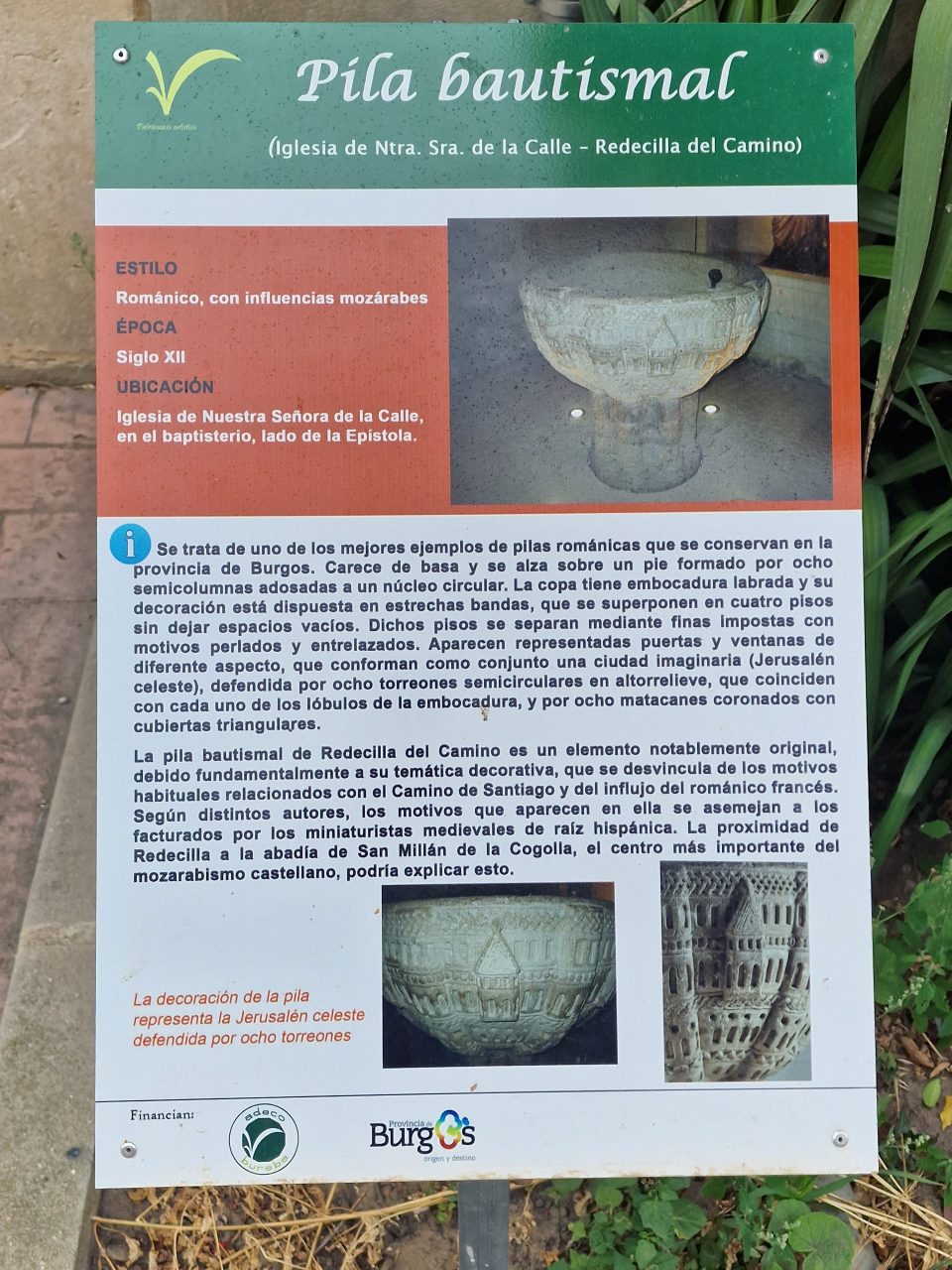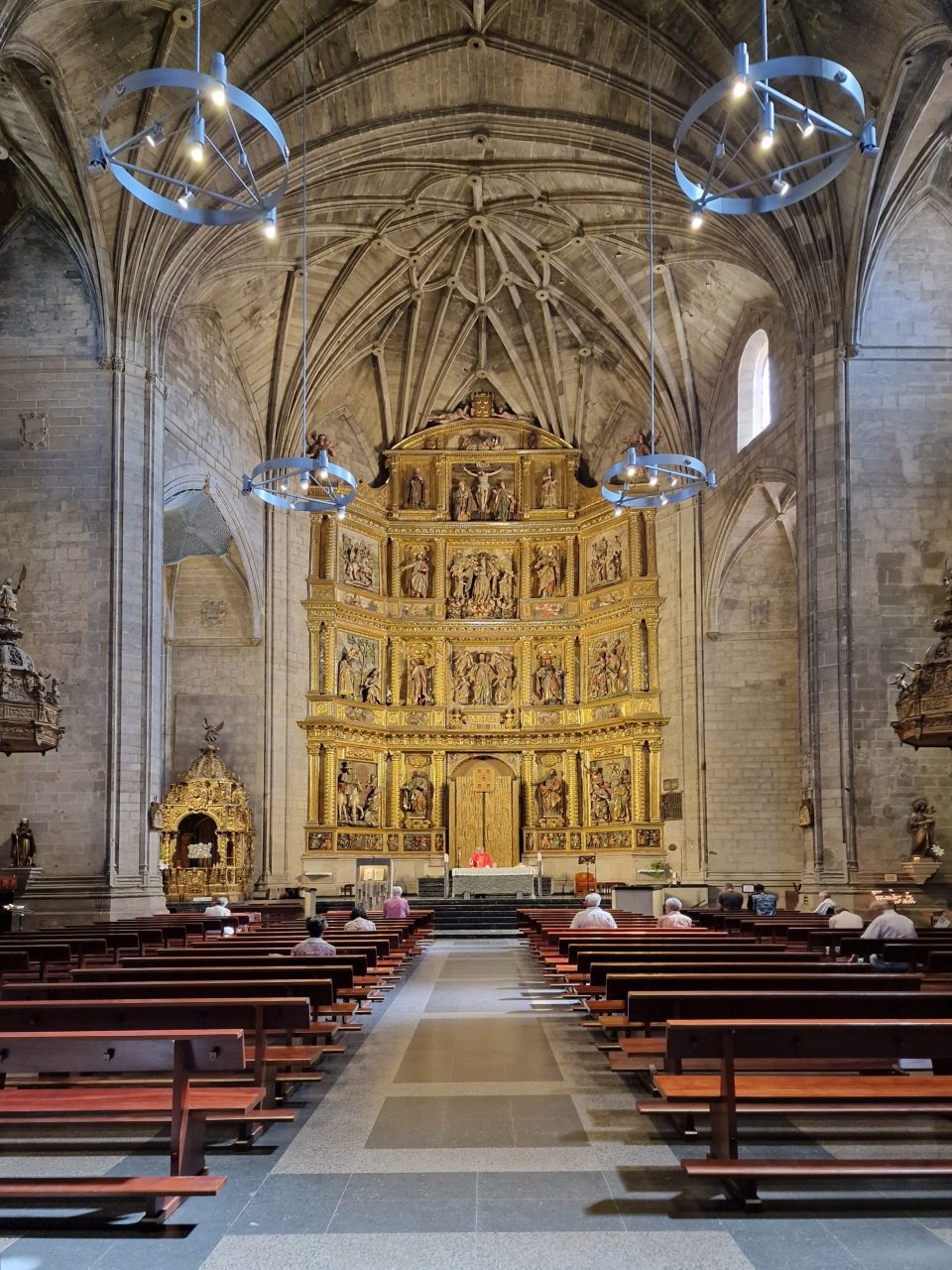Monday 28 August 2023 – Since we had a slightly longer walk today – about 23km – it was convenient that the Molino de Floren offered an early breakfast, from 0630. This might be “only” a hostal, but it is well-organised and we had a comfortable night and the breakfast, while fairly simple, featured home-made yoghurt and preserves and very large receptacles for tea. So we were in good spirits as we left at 0715, having had a chat over breakfast with Phil, a solo peregrino from Maine, in the USA, who is doing the Camino despite having artificial knees. It’s good to know that the technology will stand up to this kind of usage.
As ever, if you’d like to see a short summary of the route and photos, you can watch the Relive video.
The weather promised to be pretty much the same as yesterday’s – breezy, cool, even cold (it was 16°C as we left the hotel), and with the strong likelihood that we would get rained on. As the saying goes, “Red sky in the morning – shepherd’s warning”,

and that turned out to have some merit during the day.
The fields hereabouts have got quite a sophisticated irrigation system

which is sometimes fed from available surface water but also every so often by (noisy) pumps if required. We saw yet another style of Camino waymark

and we passed Phil (who had started out before us) at a large cross,

Cruz de los Valientes, which marked the site of a dispute between the town of Santo Domingo de la Calzada and its neighbour, Grañon, over the ownership of a meadow. We read that relations between the towns was disharmonious, and this particular fight was decided in favour of Grañon. Phil seemed to know the chap sitting there, and, it being at the top of a bit of a hill, decided to rest up whilst we carried on.
We were walking into the teeth of a stiff Force 4 gusting 6 wind, and this meant that the light kept changing over the scenery, sometimes in sun, sometimes not.

To give you some idea of the chageable nature of the weather, I recorded this short hyperlapse later on in the day
which reflects one minute’s worth of cloud movement. Very soon after I recorded it, by the way, it started raining.
The cold wind meant that we were glad to see Grañon when it hoved into view in the distance

and before too long we had arrived at a refreshment stop. It wasn’t too sophisticated

but the setting was nice,

the service was very friendly and efficient (and gave us large cups of coffee), and it had couple of quirky decor touches beside it.


The town itself was a little larger than I expected and a deal more interesting. It had a fine town hall building,

more of those ants, this time on the side of a building in the main street,

a nice way of combining a manhole cover with Camino signage,

and, at the far end, a mirador, a viewpoint with some fine views over the area


including sight of a crop which was neither wheat nor sunflowers, and which was being copiously watered.
We couldn’t see what the crop was at that point, but later on in the day passed a similar setup where the crop was dwarf beans.
The landscape continued to be alternating wheat and sunflower crops, which gave us some nice pictures.

Patterns in the sunflower sowing

Cyclists actually on a path appear to be cycling through the field
Jane pointed out that this was environmentally sound graffiti – the florets were about to fall from the seed heads, and all it needs to create a pattern is to brush a finger across the head – because it disappears naturally after a time wthout any harm having been done.
Very soon, we came to a subtle reminder that we were entering the region of Castille and León,

which means that by this stage we have walked across the whole region of La Rioja from left to right.
The route for the rest of the day followed, and for large amounts of it bordered, the road between Burgos and Logroño, the N-120. It’s a pretty major route and not too rewarding to walk beside, but at least we had a segregated path for those segments. It also meant that we passed through a succession of villages, four of ’em, before we reached our destination for the day, Belorado.
The first of these was Redecilla del Camino,

which, like Santo Domingo, the town we visited yesterday, has a rollo, the site for administration of justice and, possibly, death.

Seeing this means that yesterday’s example wasn’t our last Rollo. Thank you. Thank you for listening to my joke.
The town has some handsome buildings (with balconies and armorial crests, much to Jane’s delight),

and, of course, a church – this is a pilgrimage route, after all.

The church is noted for having one of the best examples of Romanesque baptismal fonts in the province of Burgos. Shame the church was locked tight, then. As consolation, there is, outside the church, a picture and some text expatiating on it

and a sculptural representation.

which is better than nothing, albeit not by much.
The next village/town is Castildelgado.

It’s just this village, you know? Church, Ermita, some attractive buildings among the other, somewhat neglected ones. The whole place had a vibe of stagnation and slow decay.


A bar is promised

but we ignored its siren call and moved on. The next village is Vilamora de Rioja,

where we had planned to stop for coffee at the Albergue, but it was closed – and there didn’t appear to be another source of refreshment in the whole village. This was a shame – it’s a strikingly pretty village, with a very much more cared-for vibe than Castildelgado, and it’s maybe a bit surprising that such a place has just the one albergue and nothing else.
Then again, Vilamora de Rioja’s claim to fame is that it’s the birth place of Dominic de la Calzada, who later became Santo Domingo de la Calzada and founded the eopnymous village. Maybe its religious significance is why it’s (a) well-maintained and (b) not got a thriving bar culture? Anyway, it was nice to look around.





One of the buildings even had a device on its roof witch tells you the wind direction.

The house where Dominic was born is noted by a plaque (the house on the left here)

as is the church where he was baptised,

outside which there is a statue of the man.

We spent a little while here, as it was so pleasant, but then it was time to move on. The next town is called Villamayor del Rio, which is misnamed on three counts: it’s not a villa, it’s not major and there’s not a river. Apart from that, it’s all good. Well, to be honest, there was only one decent photo be had there.

And there was a coffee stop just outside it, too, which was welcome.
That left us with a stomp down the home straight into Belorado. Ahead of us was a group of peregrinas from – I’m guessing, here, but with fair confidence – Korea. I was amused by the hat of the one in the lead.
If a hat I was wearing was doing that I would take it off. We had a small battle with one of the group, a short lass who was poling along in a determined fashion between the lead two and the trailing two. Our natural pace was faster than hers, but as we drew level, she accelerated, I don’t know whether this was conscious or not, but it was very noticeable. We in turn upped our pace, as did she, but our legs were longer and eventually we completed the overtaking manoeuvre and surged ahead. Of course, being British, this meant that we had to stick to this increased pace for the rest of the walk into Belorado, as it would have been just awkward to be passed and then have to re-pass, and so on.
Belorado is a delight, with all sorts of colourful and interesting quirks. As you approach, there is an albergue which greets all passers by who are tired

or flagging. Unlike the other towns today, which you can see from miles away, you just turn a corner and

there you are, really. Our walk to our hotel gave us a good flavour of the idiosyncratic nature of the town, with a whole series of murals greeting us at practically every turn.
There are many attractive buildings
and near our hotel is a litle parklet where they have crocheted the trees and seats

as well as the railings.
Many of the buildings are lavishly decorated,


and the church has stork’s nests on it.

There are caves behind the church – some fitted out with windows!

Generally, the place has a genial, bonkers feel to it – it’s delightful to wander around.
We had a satisfyingly late lunch at a restaurant near the hotel called Garain. It was a nice lunch, rather than a Nice Lunch – we had the menu of the day rather than a slap-up meal with silver service and that – and we enjoyed being in the back room of a bar, troughing it with other locals – the first time we’d had this kind of meal. Good food and half the price of the Nice Lunch we’d had yesterday.
After it, we went for a walk. Obviously. Many of the things we saw I’ve described above, and we also went into the main church, Santa Maria. By and large, it’s just this church, with churchy stuff inside it

but there are a couple of things of note. The first is a pair of effigies of saints on their processional mounts. The more interesting one is San Vitores, a patron saint of Belorado, who was decapitated, as you can see from his statue.

The other point of interest is an altar and retablo in a chapel which is carved in stone rather than fashioned in wood.

It depicts St. James – Santiago – as both the slayer of moors (above) and pilgrim (below). An interesting piece of workmanship.
This completes the story of the day. Despite several rain showers whilst we were out walking, it’s been a good one, with a decent distance – 22.9km – covered comfortably (and in rain jackets against the cold). This brings our total to 239km exactly, just over 148 miles. Tomorrow, continuing the trend of ever-increasing distances, we have to get to San Juan de Ortega, which is 24km with something of a hill in the middle. The weather prospects continue to be for cool, breezy weather for the next couple of days, which, frankly, is fine by me – we have so far been able to cover this kind of distance without discomfort or even needing to take lots of water with us, which saves on pack weight. It will warm up eventually and our approach will change accordingly; but for the moment, we’re looking forward to another day’s peregrination.
Come back soon and find out how it went, won’t you?




















































































